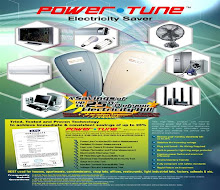
EARTHING
1.0 Introduction
As required by various authority such as Jabatan Bekalan Elektrik & Gas Malaysia, which is now known as Suruhanjaya Tenaga, MSIEC and TNB, it is essential to ascertain the earthing arrangement at the source of supply of an installation and the type of path intended for earth fault current to flow in order to select the appropriate protective measures to be used for the protection against electric shock.
2.0 Classification of Earthing System
The earthing system is classified with the following letter designations:
Supply authority or supply source earthing arrangements are indicated by the first letter:
T : One or more points of supply are directly connected to earth
I : Supply system not earth, or one point earth through a fault limiting impedance
Relationship of exposed conductive parts to earth are indicated by the second letter
T : Exposed conductive parts connected directly to earth and which is independent of the supply earth
N : Exposed conductive parts connected directly to the earth point of the source of the electrical supply
Arrangement of neutral and protective conductors in T-N System is indicated by a third letter
S : Separate neutral and protective conductors
C : Neutral and protective conductors combined in a single conductor
Thus the types of system are:
TN – C
TN – S
TN – C – S
TT
IT
The earthing system that are commonly used by consumer here in Malaysia are as follows:
a. TT system is used by consumers connected to TNB supply by overhead lines service.
b. Combination of TT and TN–S system are used when supply is connected by underground cable. This practice is used when consumer is unable to provide earthing resistance of adequate value. The normal indemnity clause will be include in the supply contract.
The importance of earthing lies in the fact that it deals with safety. Earthing requirements for electrical system are well define in ELECTRICAL REGULATIONS, 1994. The system earthing is the responsibility of TNB but the consumer is responsible for the earthing of his installation.
The important of earthing are:
1. In power systems it helps to maintain the voltage of any part of the network at a definite potential with respect to earth.
2. And it allows enough current to flow fast enough under earth fault conditions to operate the protective devices installed in the circuits.
3. Preventing exposed conductive parts of the equipment from rising in potential for a period sufficient to cause danger from electrocution.
For normal installation practice, earthing is to connect together the exposed conductive parts of various items of the equipment and to a common terminal (main earthing terminal) : this in turn is connected by the earthing conductor to an earth electrode, buried in the mass of earth. The earth installation must be capable of carrying the prospective fault currents without danger and without excessive heat. It must have low resistance at all times with good resistance to corrosion.
The most important part of the earthing system is the electrodes. Earth electrodes are made from a number of materials like cast iron, steel, copper or stainless steel, and they may be in the from of plates, tubes , rods or strips.
The most favored material is copper. It has good conductivity, is corrosion resistance to many of the salts that exist in the soil and it is a material that easily worked.
The earth resistance depends on soil resistivity and characteristics. The types of soil suitable for earth electrode are: -
Wet marshy ground
Clay, loam soil, arable land
Clayey soil, loam mixed with small quantity of sand
Damp and wet sand
The site should not be well drained and without flowing water which will wash away the salt in the soil.
Achieving a good earth will depend on local soil condition. Three factors that affect the soil resistivity are:-
Moisture content of the soil
Chemical composition of the soil
2.1 Temperature Of The Soil
In area of high soil resistivity, it is difficult to obtain an earth resistance of, say one ohm or less. Several options are available in the form of soil conditioning agents. e.g. copper sulphate, sodium carbonate, bentonite and marconite.
The key to arriving at a successful earthing electrode system is not to sacrifice quality for cost. Many products currently on the market fall far short of the recommended standards. The redraft of CP 1013, when available, will contain recommendations for materials specification to ensure components are corrosive resistance and provide adequate mechanical strength.
3.0 Earth Electrodes ( 542–10 to 15 )
These consist of some form of deeply buried conductor since the major earth resistance lies on the top soil.
Buried copper or galvanized earth plates have largely given place to threaded copper-clad steel-cored rods. Penetration is by hammer blows, the threading permitting the linking of successive lengths.
The following items are recognized by the IEE regulations as suitable earth electrodes.
Earth roots or pipes
Earth tapes or wires
Earth plates
Earth electrodes embedded in foundation
Metallic reinforcement of concrete structures
Metal pipes
Lead sheaths or other metallic coverings of cables
4.0 Earth Electrodes for Area of Rocky – Soil Structure
In area where there is rock at or near to the surface of the soil, copper tape, stranded conductors or wire mesh electrodes may be used.
These types of electrodes should be buried to a depth of not less than 457 mm to minimize the risk of their becoming damaged and to protect them from climatic conditions such as frost.
5. Methods of Installing Tapes or Stranded Conductors
Copper tapes and stranded conductors can be arranged in single lengths, or as parallel or radial groups. The usual size of copper tape is 25 mm wide by 3 mm thick.
6. Earth Rods
Earth rods are used where low prospective fault currents exist and the soil resistivity high.
7. Method of Installing Earth Rods
Earth rods are driven completely below ground using hand – held hammer or power hammer.
They are set out at a distance of not LESS than their own length apart ( CP 1013 1965 )
8. Inspection Covers
Constructed of concrete with a galvanised steel lifting handle. The underside is recessed to enclose and protect the electrode connection
Standard parthway covers with cast iron frames with a concrete filling may also be used
Glazed earthenware and fibre glass covers are also available
9. Termination To Earth Electrodes
The connections of earthing conductors to electrodes require adequate insulation where they enter the ground, to avoid possible dangerous voltage gradient at the surface. All electrode connections must be thoroughly protected against corrosion and mechanical failure.
It is important that the electrode is made accessible for inspection purpose, and a label should be fitted at or near the point of connection.




.jpg)
.jpg)
.jpg)

alum powder online
ReplyDeletei need help. my floor in my bedroom sometimes have leakage which everyone dont know from where. it happened sometimes when touching my bed or iron table. I have check and doing new earthing system but the problem still exist.
ReplyDeleteVery good article. Is it possible to post some circuit sketches for TT Earthing and Bonding Designs
ReplyDelete